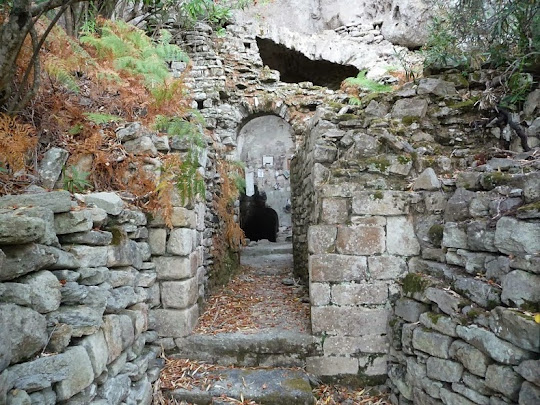When Vadim Kolpakov went on an expedition to the north of Irkutsk region, he had no inkling of the sensational discovery he was about to make.
Having an official task to draw up a geological map of the region, a young geologist ended up running into something so unique, outstanding and mysterious that it would still puzzle scientists more than six decades later - the Patomskiy crater.
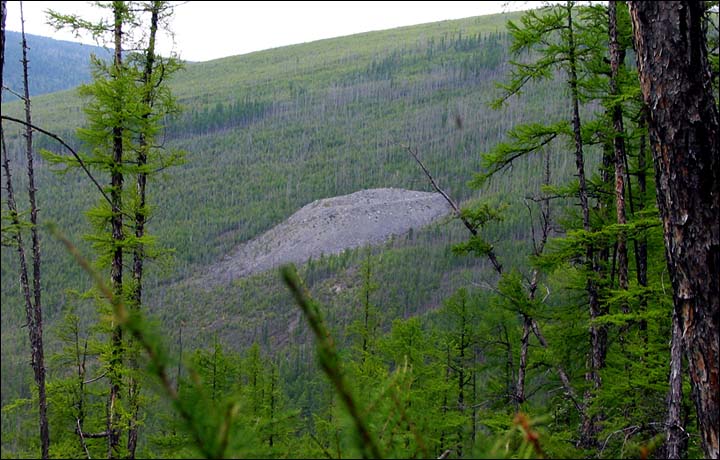
Patomskiy crater, Irkutsk region, pictured in 2006.
host of theories have been put forward in the intervening years: that the crater was created by an ancient civilisation, or by prisoners at a top secret Stalin labour camp, or by volcanic activity, or by a meteorite, or by an underground hydrogen explosion, or by a UFO. And even more tantalising: by two UFOs.
Stories have been handed down by native people - who knew about the 'cursed crater' long before Kolpakov revealed it to the outside world. Among these accounts, were warnings that this 'Devil's Place' was dangerous to humans.
Questions remain unanswered about a phenomenon that has been called 'The Most Mysterious Place in Russia'. For example, why don't trees grow on the side of the cone-like structure? Radiation levels are low now, but there is evidence they were once very high: why?
Despite a number of expeditions by eminent scientists, no-one has yet come up with an undisputed answer to what - or who - created this strange structure. A new mission to the remote crater is due in the coming months seeking to finally answer this question.

Aerial view of Patomskiy crater, Irkutsk region.
In August 1949, when Kolpakov reached the very north of Irkutsk region, local Yakut people told him a story about an 'evil' place, hidden in the woods.
They called it the Fire Eagle Nest, and according to them even the deer didn't dare to go close to it. Locals told a lot of legends about it, warning people would suddenly start feeling unwell or even disappear, some to be found dead later, some never to be found.
As recently as 2005, indeed, the head of a mission to the crater died suddenly within several kilometres of it.
Legends didn't scare Kolpakov back in 1949 but what he witnessed in a distance when he climbed up the hill was shocking.
'When I first saw the crater I thought that I'd gone crazy because of the heat,' he noted. 'And indeed a perfectly shaped mount of a size of a 25-storey building with a chopped off top sitting in the middle of the woods was quite an unexpected discovery.
'From a distance it looked like a mine-shaft slagheap, only whitish. I even thought, 'Where are the people?' There were no labour camps in the area. Unless a very, very secret one?
'My second thought was an archaeological artifact. But the local Evenks and Yakuts, with my respect for them, are not the ancient Egyptians. They could not build stone pyramids, and didn't have any human resources nor the necessary scientific knowledge."
He ventured gingerly towards the strange shape, like no other anywhere nearby.
'I got closer and realised that the mysterious hill was not the work of a human', said Kolpakov. 'It rather looked like a perfectly round mouth of a volcano with a height of 70 metres. But volcanoes have not appeared on the border of Yakutia and Irkutsk region for several million years. And the crater was pretty fresh. It is located on the slope of a hill overgrown with larch.
'The trees still did not grow on the slopes and in the crater, the winds had not brought the soil yet. I estimated the age of this anomaly at some 200 to 250 years. And another mystery - a semi-circular dome cavity with a diameter of 15 meters in the centre of a crater. In volcanoes, even extinct, such domes cannot exist.'
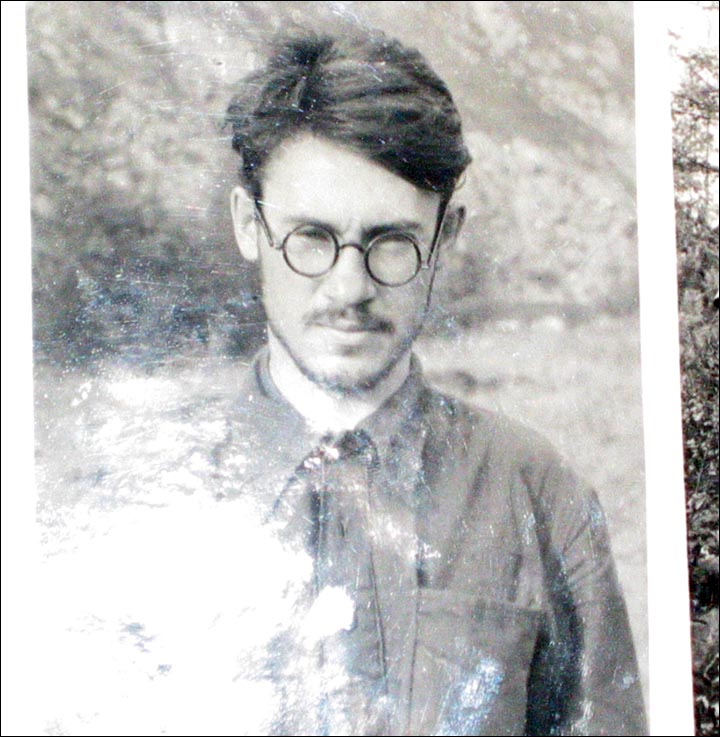
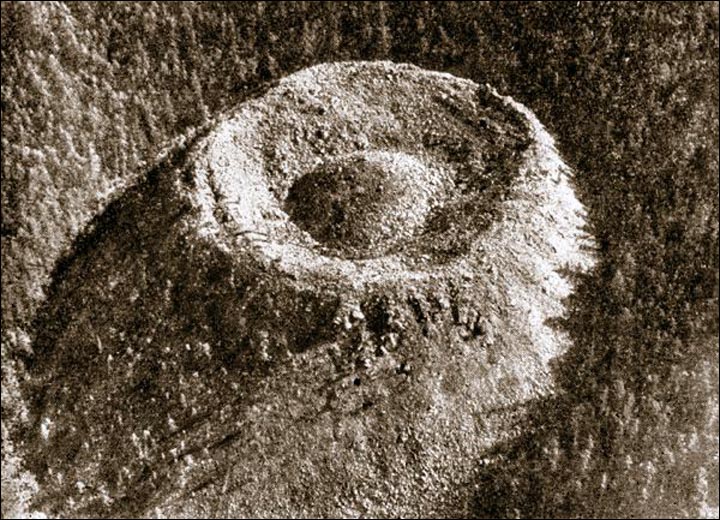
Geologist Vadim Kolpakov and, below, the first picture of Patomskiy crater taken in 1971.
Since the discovery of this mysterious place, later named Patomskiy crater, scientists came up with widely differing theories of its origin: among them, an unknown underground explosion to the fall from space of a mysterious super dense substance unknown to man.
Or even the UFO.
But not a single one of these theories could fully explain the anomalies of the crater and the processes that still go on inside it.
The first and the most widespread explanation initially was, unsurprisingly, that ventured by Vadim Kolpakov, the Russian discoverer of the crater. After his expedition, in a scientific article he postulated that the crater was the trace of a meteorite.
Later, other scientists, namely the geologist Alexander Portnov, came to the same conclusion, arguing that it could easily be former by a piece of space rock that sliced off the famous Tunguska meteoroid that exploded over Krasnoyarsk region, to the west of Patomskiy Crater, in 1908.
Another early explanation was that the crater had volcanic origin. The shape superficially suggested this. Amateurs looking at it might see this as a probable theory. They may yet be right.
Seven years ago another important expedition to Patomskiy crater was lead by an experienced geologist, Eugeny Vorobiev. On 1 August 2005 it landed in the city of Badaybo, the nearest point to the crater accessible to aircraft. From Bodaybo the road goes only for 200km: for the rest of the way hiking boots and boats are needed.
'The problem was that the budget the expedition had allowed the members only to fly to Bodaybo, and the rest was up to us. This is not the way expeditions should be set up,' bemoaned the head of the Observatory of Irkutsk State University, Professor Sergey Yazev. 'There were some dangerous areas along the way but fortunately we made it safely.'
Yet they were still struck by tragedy. When the expedition had only a short way to go to the Potomskiy Crater, its leader Vorobiev suddenly fell to the ground. His colleagues rushed to help him but it was too late - Vorobiev was dead. Back in Irkutsk the doctors diagnosed the cause as a heart attack, but his demise continued the crater's association, mentioned by native peoples, with death.
'Such a horrible thing happened,' said Sergey Yazev. 'It was a big question what to do next, but as the expedition was so close to the crater, four scientists decided to continue the expedition in honour of Eugene Vorobiev who wanted to reach it so much.'
They were astonished when they glimped the crater.
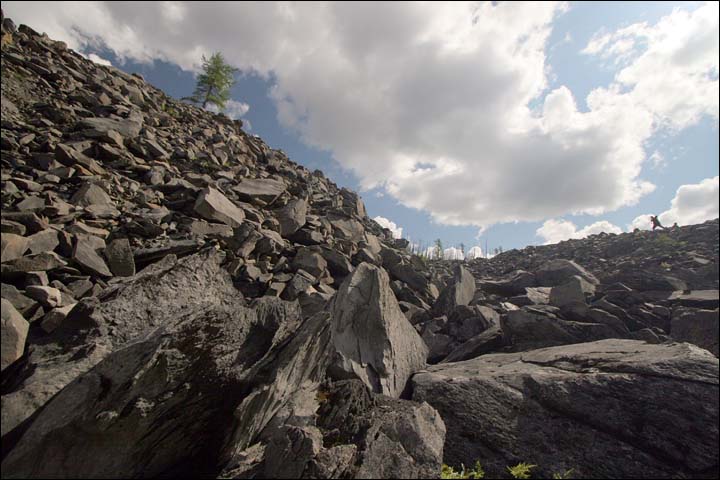
View from inside the Patomskiy crater, Irkutsk region. Picture: The Siberian Times
'It was breathtaking. What could have brought to life this strange object? 250,000 cubic metres of underground rock pushed to the surface in a very regular round shape.
'We thought that once we reached the crater we would immediately understand its origin but we left the place even more puzzled then before,' he admitted.
In 2006 and 2008 new expeditions were organised. A doctor of geological-mineralogical sciences Alexander Dmitriev, from Irkutsk State Technical University, found a magnetic anomaly within the crater during the 2006 expedition.
He presumed that there could be iron or other material that resembles it in properties at a depth of 150 meters. This begged the question: was the crater caused by a meteorite?
But the nest's shape is not at all like other locations where meteorites were found. Another expert, a doctor of physical and mathematical sciences, Igor Simonov, of Moscow Institute for Problems in Mechanics, conducted a series of intriguing experiments, and evidently established that the crater could have been formed from the fall of a cylindrical object of super dense material.
Tantalisingly, he said: 'On Earth this material is not available, but somewhere in space it may exist.'

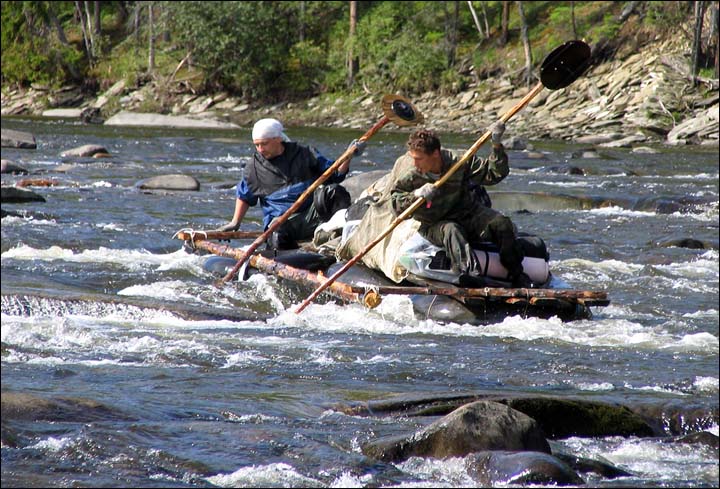
By air and by water - year 2006 expedition to the Patomskiy crater.
Professor Simonov presented his work to his colleagues. And soon, a senior research fellow, Igor Yermolaev, from the Institute of Mechanics, held another series of experiments, and proved that the falling object could be not only the cylinder, but two bodies, one after another, the first flying at a speed of more than 6.5 km per second.
'When hitting the surface the first object exploded, creating a large crater,' said Igor Yermolaev, 'and the second slowed down presumably up to 1.5 km/s, because of the explosion and went into the ground.'
So two UFOs?
'Counting the fact that two meteorites cannot fly one after the other, hitting the same spot I cannot imagine the nature of this strange object. I do not know what it is.'
However, other specialists have some thoughts about it.
A doctor of biological sciences Viktor Voronin, head of the laboratory of the Siberian Institute of Plant Physiology and Biochemistry, also visited Patomskiy crater and came up with significant findings.
'In last year's expedition, a saw cut of a larch that grew at the edge of the crater was made,' he revealed. 'As a single sample is not much use, nothing substantial except for the age of a tree was defined.
'But some strange anomaly in the growth that has occurred in the middle of the 19th century attracted my attention. Known causes, such as fire, insects and other damage, could not explain it. Therefore, during the next expedition, the collection of wood samples for dendrochronological analysis was carried out according to my plan.
'When the tree cuts from the crater were delivered to the lab, I first determined the age of each tree. The oldest, growing at its bottom, dated back to the beginning of the 16th century. It was around 480 years old.
'But the oldest tree on the slopes of the crater had grown since 1770. It turns out that Patomskiy Crater formed no later than the last date, and, logically, a little earlier ...
'A tree cannot grow on the bare rocks, so first the soil should have formed, which is another 20 years. That makes the crater at least 250 years old.'
So that was one finding.
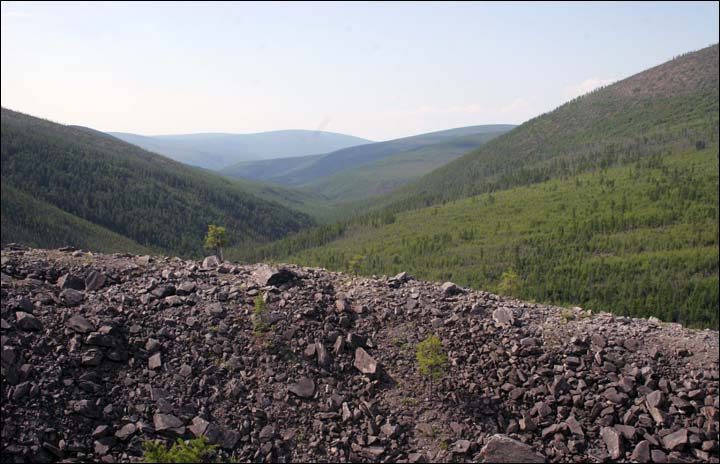
View from the edge of Patomskiy crater.
Yet Professor Voronin also found a strange anomaly in the formation of annual rings of all trees older than 200 years. Some of the trees turned out to have fallen in 1841-42, some just broke off at the same time, and in the samples the annual rings have narrowed at the same time, and soon they died.
It got more complicated when the scientists analysed the tree rings of the trees growing close to the crater. The same year, 1842, the tree rings have increased significantly. And surprisingly, held out at such a high rate for about 40 years, then rings sharply narrowed.
'The sharp jump in the growth of trees is either a sharp improvement in the mineral supply, or if some trees are cut and the remaining trees get more sunlight,' said Voronin. 'It is unlikely that the forest spilled large amounts of fertiliser.
'But there seems to have been a massive inrush, and its cause are still unclear. But the sharp reduction of growth after four decades is not typical for this situation.
'I know of only one similar case. When, after the Chernobyl disaster due to release of radiation, the growth of trees increased dramatically. Maybe we are dealing with something similar here? Yes, now the background radiation in the crater is low. But maybe at some point of time suddenly short-lived radioactive isotopes somehow got here, which had to date, break up, and later the radioactivity decreased to natural?
'A radioactive meteorite? Or, terrible to say, artificial space objects with nuclear fuel on board? There are trees that fell, and broken trees are there as well. Trees away from the crater generally grow quite inexplicably. And it happened in the same years. In general, it is a mysterious story.'
Is he really suggesting the remains of an alien space craft might lie inside the crater?
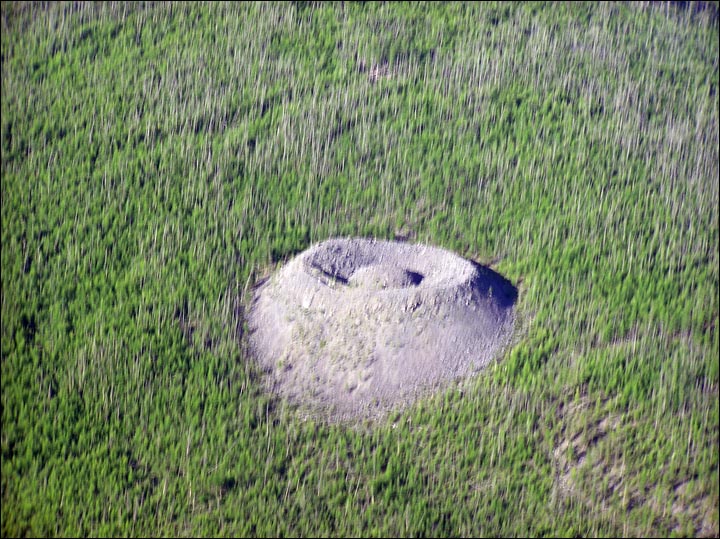
Aerial view of Patomskiy crater, Irkutsk region.
He answers by explaining that the mid-19th century leap in isotopes is equivalent to the patterns that occurred in nuclear arms tests.
In an NTV documentary aired in March 2012, he said: 'It was an incredible, mad jump of both strontium and uranium.
'I am a biologist - not a geologist or a physicist - and so can allow myself certain liberties.
'And it was me who first voiced the version about the UFO apparatus falling there with its nuclear engine still on.
'So at first it hit the ground - and raised the first cone. The several hundred years later the engine blew up, and pushed the middle bit of the crater up. This is where strontium and uranium came from.
'It was my theory of a UFO origin of it.'
Today, contacted by The Siberian Times, he concedes subsequent work on the crater has thrown up another more likely explanation, though even this is not foolproof.

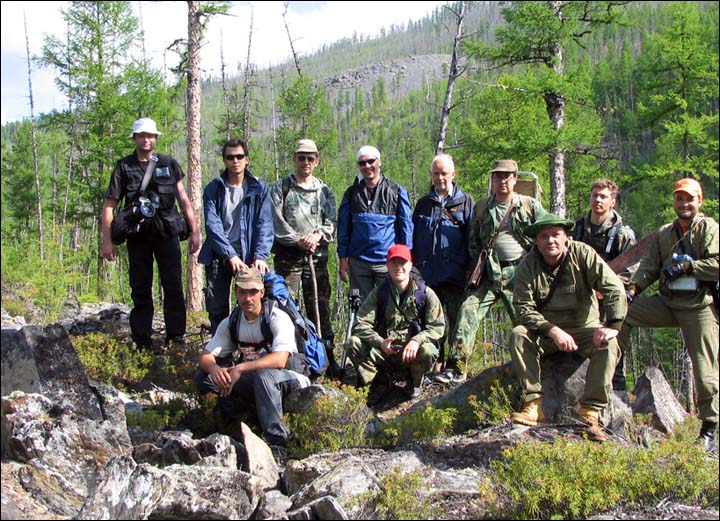
Year 2006 expedition to Patomskiy crater and, above, Vadim Kolpakov and his wife studying the pictures the expedition made.
He has taken a good measure of criticism for his UFO theory yet he still says other explanations are - as yet - not definitive.
'My NTV quote was a while ago, and since that time we've made a number of experiments and analyses that showed that most likely it is a volcano. Yes, the only one like this on this territory,' he said.
'It is not a typical lava volcano, but just at some point gas exploded there.
'Of course, there are many strange things still about the crater. There is no unified, definite consensus yet about it. Together with geomorphologists we have decided that it is the most likely version.
'The strange thing that doesn't fit the theory, however, is that if it was a gas explosion, it would not have raised the temperature. And there for a while the process of surface heating was certainly going on, there was an increased temperature level.
'This is why I was saying to my fellow scientists 'Guys, it must have been a nuclear reactor working there.' Their answer was 'How would it get there/' and 'There are no traces of radioactivity there'
Then - I know it sounds funny that a biologist reminded geochemists about it - I recalled to them that there are short living isotopes that last for only 30-40 years.
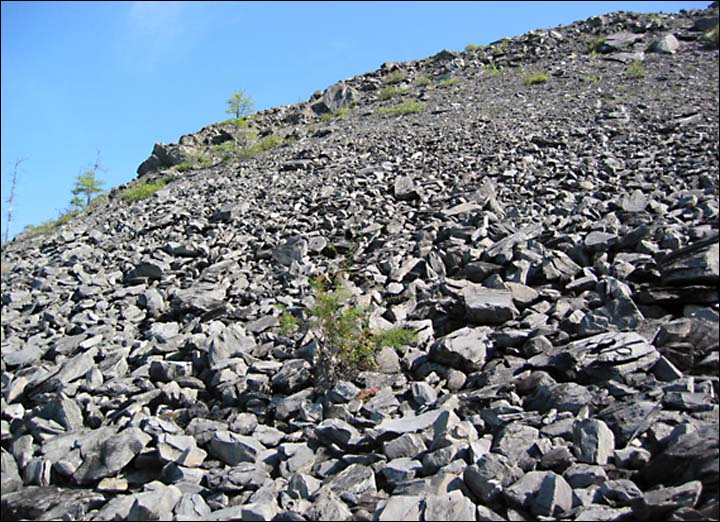
Slope of Patomskiy crater, Irkutsk region.
'That event with an increased temperature level was in 1842 - I can give the exact year thanks to the tree growth rings analyses. That was the year when the trees were falling there en mass, and this is when they all got scars.
'And the same date was mentioned completely separately from me by geomorphologists. They said that approximately then (in the 1840s) something happened there, an explosion, or a kind of a push, shove.'
Analysis of trees sent by Voronin to the Novosibirsk Budker Nuclear Researching Institute found that during that period the growth rings showed a sudden jump of strontium and uranium, up three or four levels higher than norm, and held like this for about 20 years - and then went back down.
So where was this radioactivity from if it was a 'gas volcano'?
'This was exactly my questions to geo-chemists, and I was telling them - is it a reactor under the crater? Their answer was - what reactor, where would it come from? But then where did the radioactive elements came from?
'They still haven't answered. But we are getting towards the more reasoned position that says let's forget it the radioactivity and that it looks most likely like volcano....
'But, yes, the question where the radioactivity comes from remains unanswered. No-one can definitely and clearly explain it.

Aerial view of Patomskiy crater, Irkutsk region.
'So the hypothesis is quite approximate still, but I do think that geomorphologists opinion is the most correct of all, that it is a gas volcano.
'It also shows the typical ways of rising for the gas volcano - when gas keeps gathering inside the chamber, then there is an explosion that rises the ground, and gas starts gathering again. Then another explosion, and again the ground rises.'
Alexander Pospeev, a doctor of geological and mineralogical sciences, insists the explanation is more prosaic, and less extra-terrestrial.
'Even now, the origin of the crater is not discovered, but we can say for sure that it has the earthly origin,' he stated. 'It could be caused by the underground release of some fluids such as hydrogen. Maybe some other fluid, that's what we do not know exactly.
'But studies have now shown that there is no object like the fragments of an asteroid or some metal object under the crater, as has been suggested.
'This is pretty interesting place without being connected to some mysterious tales. I'm a scientist and I don't believe in UFOs. I do believe that there is an explanation to every mystery, sometimes simpler, sometimes, as in our case, more difficult.....
Pospeev also has a mundane explanation as for the odd tree rings, insisting - contrary to Voronin - that a gas-based eruption could raise the temperature.
'The changes in the size of rings discovered by Professor Voronin was caused by the release of heat, which accompanied the underground release of the fluid and later when the temperature went back to normal, the ring changed their size back.
'There were no trace of radiation found around the crater. The radiation level there is much lower than in (the city of) Irkutsk.'
Critics may argue that there is a shortage of other such structures. Surely if this was the cause there would be other examples? He claimed there maybe other examples which are - for now - hidden to us, while also acknowledging that the crater has not yet given up all its secrets in terms of finally establishing beyond doubt its cause.
'It can be quite strange that such cases were not seen before, but we are talking about geophysics,' he said.
'For this, in science hundreds of years lasts like a second. We cannot say that in the same area there are no similar objects much older then Patomskiy crater but now just crumbled and overgrown with trees so they have never been discovered by man.
'In fact, in the area there are three or four volcanoes, so it can be that the phenomenon is not quite unique.
'Each expedition has a tremendous value for the study of the crater. There is a huge difference between our knowledge about the crater when we first started the expeditions and now.
'There is a great interest in solving the mystery of Patomskiy Crater and I hope in ten years we will be able to fully solve its riddle.'
Another mission to Patomskiy is planned in the coming months. 'I hope it will find some new facts that will help to reveal the secrets of the crater', he said.
Source























































